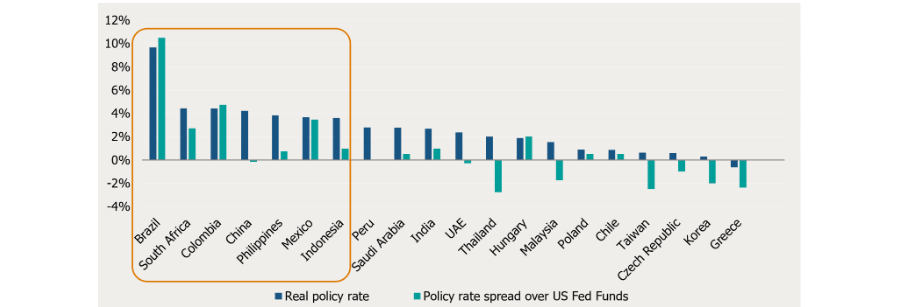Periods of dollar weakness have historically delivered the strongest returns for emerging markets. That pattern may be repeating today as the dollar softens and conditions improve across many emerging economies.
Inflation is easing, interest rates remain relatively high, and central banks have room to support growth.
At the same time, emerging market (EM) equities are still trading at a clear discount to developed market levels, offering investors both return potential and enhanced portfolio diversification at a meaningful discount.
Why dollar weakness matters
Over the past three decades, periods of EM equity outperformance have coincided with dollar weakness. When capital shifts from the US into global markets, emerging economies typically experience stronger currencies, lower import costs, and easier financial conditions.
This combination has historically provided a powerful lift to both domestic growth and asset prices in EM economies. Although global trade policy remains unsettled, activity has held up, and today’s backdrop resembles prior supportive periods.
In this stage of the dollar cycle, emerging markets offer a rare combination of cyclical upside, structural diversification, and attractive entry valuations.

Source: JOHCM
Where opportunity lies
Emerging markets today can be grouped by their structural positioning:
- Deep market countries
Taiwan, Korea, Hong Kong, and the UAE benefit from well-developed financial markets. Their currencies have strengthened as the dollar has fallen, although reliance on exports may make further gains harder to sustain in the short term.
- Dollar-anchored economies
Saudi Arabia, Thailand, and Malaysia hold substantial dollar savings but their exchange rates are strictly managed against the dollar. As a result, their prospects depend more on external moves in the dollar than on domestic policy.
- Borrower nations
Brazil, Mexico, Indonesia, and India are best placed to benefit from this phase of the cycle. In these countries, stronger currencies and lower inflation allow central banks to cut rates, creating a backdrop that is typically favourable for equities.
- China
China sits outside these categories. Its currency is tightly managed, reducing sensitivity to external dynamics. The outlook there will depend on the scale of stimulus chosen by policymakers.

Source: JOHCM
The case for investors
Economic growth in emerging markets has been substantially faster than in developed markets over the past 10 years, yet equity market returns have lagged. That is consistent with a historical pattern of cyclicality in returns from the emerging market equity asset class.
Periods of dollar weakness have historically delivered the strongest returns for emerging markets. That pattern may be repeating today as the dollar weakens and conditions improve across many EM economies.
Emerging markets remain overlooked, with EM equities still trading at a clear discount to developed market levels, offering investors both return potential and enhanced portfolio diversification at a meaningful discount.
Ada Chan is the senior fund manager of JOHCM Global Emerging Markets Opportunities. The views expressed above should not be taken as investment advice.





